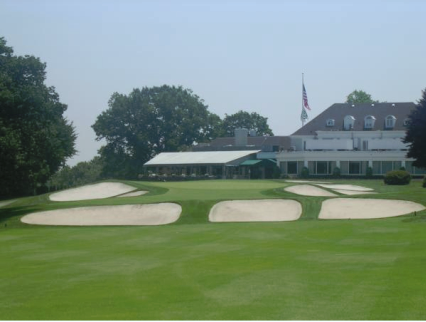Fresh Meadow Country Club

Fresh Meadow golf course first opened for play in 1923. The course was designed by A.W. Tillinghast.
Gene Sarazen was hired as professional in 1925. The Squire brought along his mentor, Al Ciuci, to teach and run the shop. Ciuci remained until 1972.
Fresh Meadow gained national prominence during the 1930 PGA Championship. Tommy Armour won the title after a back-and-forth struggle with Sarazen in the finals.
With the 1931 U.S. Open scheduled at his home club, Sarazen resigned his position at Fresh Meadow and took a similar position at nearby Lakeville. Sarazen believed the "home pro jinx" had cost him the 1930 PGA, and he was taking no chances.
Sarazen is said to have played conservatively during the first two rounds, a tactic that seemed all the more questionable in light of his mastery of his newly devised sand iron. He considered himself even money to get up-and-down from any greenside bunker. Nonetheless, Sarazen found himself seven strokes back heading for the ninth tee Saturday morning. A birdie there touched off one of the great finishes in Open history. Throwing caution to the wind and shooting for the flag on every hole, Sarazen played the final 28 holes in 100 strokes, finishing the tournament with rounds of 70-66 to equal the Open record of 286.
In the 1946, Fresh Meadow's was sold for financial reasons. Tillinghast's great course soon became a housing development. Fresh Meadow Country Club purchased the nearby and financially troubled Lakeville Club. During the WW ll, Lakeville was leased to nearby Glen Oaks, because the grounds of Glen Oaks had been taken over by the U.S. Navy. After the war, Glen Oaks was returned by the Navy to Glen Oaks and Lakeville was sold to Fresh Meadow.
The Lakeview Golf & Country Club golf course (the current Fresh Meadow Country Club golf course) opened on Memorial Day, 1925. The course was designed by Charles Alison.
Fresh Meadow is a parkland course. Its fairways follow the natural roll of the forested terrain, the trees intrude dangerously close to fairways. Several tees are elevated well above the fairway, presenting vistas hardly conducive to keeping one's eye on the ball. Almost every hole spotlights the artistry of Alison's bunkering. The deep-faced "Alisons" that gained him everlasting fame in Japan are in evidence.
#11 is a beautiful par three. The elevated tee is well above the green, which is set in a natural amphitheater. Tall dogwoods tower over the green, which is flanked by six artistically shaped bunkers.
#12 is one of Long Island's great par fours. From an elevated tee, it plays into a valley once used by the local Indians for councils. A forest close on the left threatens the drive, as do bunkers right. The hole then doglegs left around protruding trees and climbs sharply to an elevated green protected by a pair of bunkers on the right. A bit of hillside falls in front of the green, confusing the golfer trying to judge distance remaining to the pin.
#13 is a beautiful par three played from a raised tee over water to an elevated green surrounded by bunkers. In the middle of the lake is an island complete with a pagoda and a large weeping willow.
#18 is a classic example of Alison's bunkering. A row of three high-lipped bunkers rise like a wave across the fairway about 75 yards ahead of the green. It is a fitting finish to an exquisite golf experience.